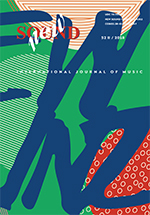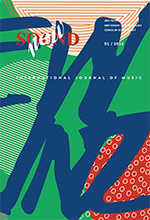Issue No. 25
Composer Speaks
Anica Sabo – POLYPHONY OF MIRJANA ŽIVKOVIĆ'S PEDGOGICAL, THEORETICAL AND COMPOSING WORK
Download: ser / eng
Studies
Roksanda Pejović – SCENES WITH MUSICAL INSTRUMENTS IN BYZANTINE AND POST-BYZANTINE ART
Abstract: Scenes with musical instruments in Byzantine and Post-Byzantine art encompassed the regions of Asia and Europe influenced the painting of Orthodox peoples made for Serbian rulers on the art of Bulgarian and Romanian soil. Musical instruments, which were present on the miniatures, mosaics, sculptures and frescoes in the early times, in time were submitted to some changes, simultaneously with compositions on which they were presented.
Ancient and early Christian thematic with scenes of organs, diaulos, transverse flutes, salpinxs, various types of castanets and crotales, cymbals, drums and small drums, harp psalteries and harps, in the later period are changed with new themes – only some of them were fostered, primarily those connected with King David and his life. In the most typical later compositions, The Nativity of Christ, The Day of Judgment and The Mocking of Christ can be considered a richer selection of musical instruments is on the scenes David and the musicians, on the illustrations of the 150. Psalm and The Mocking of Christ. String instrument (lyra, psaltery, harp psaltery or harp) is often in David’s hand, while musical instruments on the scenes of David and musicians and on the illustrations of the 150. Psalm mainly depended on the text of David’s psalms and the time in which they are painted. The most typical for The Mocking of Christ are long wind instruments – horns, buisines or S-trumpets – and above all a drum-tapan, one of the most characteristic instruments of the Balkan region.
Download: ser / eng
Lauren Y. Kajikawa – AN ESCAPE FROM THE PLANET OF THE APES: ACCOUNTING FOR CORNELIUS’S INTERNATIONAL RECEPTION
Abstract: Electronic/rock musician Cornelius (Keigo Oyamada) belongs to a loosely constructed genre of Japanese pop termed “Shibuya-kei.” Groups in this genre—Pizzicato Five, Flipper’s Guitar, and Scha Dara Parr among others—emulate the sounds and textures of pre-existing tunes, transforming Western popular music and creating a new and unique sound that has become a source of pride to Japanese music enthusiasts. Cornelius has produced a number of imaginative CDs and videos, and fans and critics in North America, Western Europe, and Australia have embraced his work. Yet Cornelius’s popularity, which is a rare occurrence for a Japanese pop musician in the West, raises a number of interesting questions about how listeners interpret music across boundaries of language and culture. First, this paper explores how Cornelius has been received by American critics, arguing that written reviews of his music stand as acts of “translation” that interpolate Cornelius’s music into Western discourses while overlooking the Japanese cultural context from which such work emerges. Secondly, this paper draws on published interviews to contextualize Cornelius’s use of “blank parody” as a possible defense strategy against this burden of Western civilization. And finally, this paper offers its own interpretation of Cornelius’s musical significance: Putting forward a utopian, post-national, cybernetic artistic vision, Cornelius’s electronic music collages avoid invoking racialized bodies in ways that have been problematic for Japanese jazz, rock, and hip-hop musicians. Using digital technology to “play” with sound information, he offers a musical analogue to the work of Japanese cultural critic Akira Asada whose postmodern philosophy was influential during the late 1980s/early 1990s.
Download: ser / eng
Interpretations
Ivana Medić – THE STOCKHAUSEN COMPOSITION AND INTERPRETATION COURSES
Abstract: This article deals with Karlheinz Stockhausen’s Summer Courses, which take place annually in a German town Kürten, near Cologne. Last year (between July 31 and August 9) the courses in composition and interpretation hosted 132 participants from 25 countries. The event consisted of: Stockhausen’s own lectures, the lectures of Australian composer and musicologist Richard Toop, then, master classes in interpretation held by Sotckhausen’s permanent collaborators such as Suzanne Stephens (clarinet), Kathinka Pasveer (flute), Hubert Meyer (voice), Alain Louafi (dance) etc. Also, nine concerts were held – six of them were given by the professors, and three concerts by the selected participants – with a total of 29 Stockhausen’s works performed; most of them were the pieces from his monumental, recently finished, opera cycle Licht (Light).
Download: ser / eng
Anders Beyer – OUR DREAM OF AN ALLIANCE
Abstract: The article is a survey in Nordic music and music institutions. From a historical approach the author tries to isolate and qualify distinct areas in Nordic music culture. He suggests that the musical institutions in the Nordic countries are too deeply rooted in the conventional, central-European criteria, and should act and compete more on the background of cultural roots on the different Nordic traditions. He thinks, on the one hand, that one cannot conceive of the North without its own historic setting. On the other hand, in the overall description we shall maintain that the story of the North is not one of isolation but rather a story of the influence of and rejection by the wider world. In order to find the necessary perspective, the patterns from the wider world must be brought into the picture albeit in the background, in as much as as we are permitting ourselves to place the Nordic motif in the foreground. Understanding this context is necessary and vital to any discussion about the North as against the world at large, when views tend to be polarised. The article describes furthermore important features and challenges en each of the five Nordic countries; seen from outside all five Nordic countries might look alike, but a closer look reveals a variety of differences alongside with shared values and viewpoints.
Download: ser / eng
New Works
Jelena Novak – THE LATEST SERBIAN OPERA: AN ESSAY ON PHANTASMS OF TRADITION, GENDER IDENTITIES AND REPRESENTATION IN THE MUSICAL THEATRE
Download: ser / eng
Vesna Mikić – SUBVERSION OF REVERSIBILITY/REVERSIBILITY OF SUBVERSION. SVETLANA SAVIĆ: RE-VERZIJE 1–6 ZA KAMERNI ANSAMBL (RE-VERSIO 1–6 FOR CHAMBER ENSEMBLE)
Abstract: Paper examines the most recent piece by Belgrade composer Svetlana Savic, performed at the 36th BEMUS festival. The piece is studied trough three “analytical essays” that raise the questions concerning the various ways of discussing the piece of music in general. Cultural analytical discourse is stressed, as well as possibility to read this piece as a specific product of subversion.
Download: ser / eng
Research and Tradition
Marija Ćirić – THE “EIGHTH ART”: THE FIRST STEPS OF RADIO BROADCASTING
Abstract: The reasons for study of radio broadcasting, i.e. "eight art", are numerous: the way the youngest artistic discipline is conceived, the directness of its communication, as well as discrepancy that could be observed in the way it's poetics could be perceived and circle of questions concerning the ways by which the sound sign is transformed into state of art. Trying to answer the question what radio broadcasting is and with what it deals, several different key points have been made: historical, scientifically-technological, formal and aesthetical. This kind of study includes a survey of the "eight art's" pre-history and of separating the main radio terms, such as radio diffusion and radio broadcasting. Then, there is definition of the different radio epochs and terms, including the divide into radio drama, documentary type of radio broadcasting and abstract type of radio broadcasting. Since radio drama is the first and basic expression of the "eight art", its beginnings (in the West, as well as in Serbia where 75 years ago the radio drama and radio broadcasting were born at the same time) are considered in more detail. Further, the radio broadcasting has its solid philosophical and theoretical roots in Theodor Adorno's, Benedetto Croce's, Bertholt Brecht's writings, while illustrative examples of the power of the "eight art" can be found in such a different use in Orson Wells and Adolph Hitler.
Download: ser / eng
Festivals and Symposia
Selena Rakočević – THE 23TH SYMPOSIUM OF THE STUDY GROUP ON ETHNOCHOREOLOGY OF THE INTERNATIONAL COUNCIL FOR TRADITIONAL MUSIC. Monghiordo (Italy), July 11–17, 2004
Download: ser / eng
Zorica Premate – COMPOSERS IN THE FIRST PERSON. Belgrade, Student Cultural Centre, September 16–19, 2004
Download: ser / eng
Ivana Stamatović – THE 13TH INTERNATIONAL REVIEW OF COMPOSERS. Belgrade, October 25–29, 2004
Download: ser / eng
Reviews
Katarina Tomašević – MUZIKA I MEDIJI. Zbornik radova. Univerzitet umetnosti i Fakultet muzičke umetnosti, Beograd 2004 (MUZIC AND MEDIA. Collection of works. University of Arts and Faculty of Music, Belgrade, 2004)
Download: ser / eng
Chris Walton – ROBIN HOLLOWAY: ON MUSIC. ESSAYS AND DIVERSIONS 1963–2003. Brinkworth, Claridge Press, 2003. ISBN: 1-870626-74-5
Download: ser / eng
Tatjana Marković – VESNA MIKIĆ: MUZIKA U TEHNOKULTURI (MUSIC IN TECHNOCULTURE). Belgrade, Univerzitet umetnosti (University of Arts), 2004, 236 p. ISBN: 86-7167-029-5
Download: ser / eng
Tatjana Marković – BOJANA CVEJIĆ: OTVORENO DELO U MUZICI: BULEZ, ŠTOKHAUZEN, KEJDŽ (AN OPEN WORK IN MUSIC: BOULEZ, STOCKHAUSEN, CAGE). Beograd, Studentski kulturni centar, 2004, 170 p. ISBN: 86-80957-36-4
Download: ser / eng
Defended Theses
Dragana Matić – "CLASSICALITY" IN GUSTAV MAHLER'S SYMPHONIES. Master Thesis at Florida State Univarsity
Download: ser / eng
Jelena Novak – OPERA U VREME MEDIJA (OPERA IN THE AGE OF THE MEDIA)
Download: ser / eng
Srđan Teparić – NEOKLASIČNA KONCEPCIJA TONALNOSTI IGORA STRAVINSKOG – RESEMANTIZACIJA (THE NEOCLASSICAL CONCEPTION OF TONALITY OF IGOR STRAVINSKY – RE-SEMANTIZATION)
Download: ser / eng
New Sound CD No. 25
1. Mirjana Živković: Summer Night
2. Mirjana Živković: Incantation
9-18. Sound examples with the Study: Radiophonic Pieces


